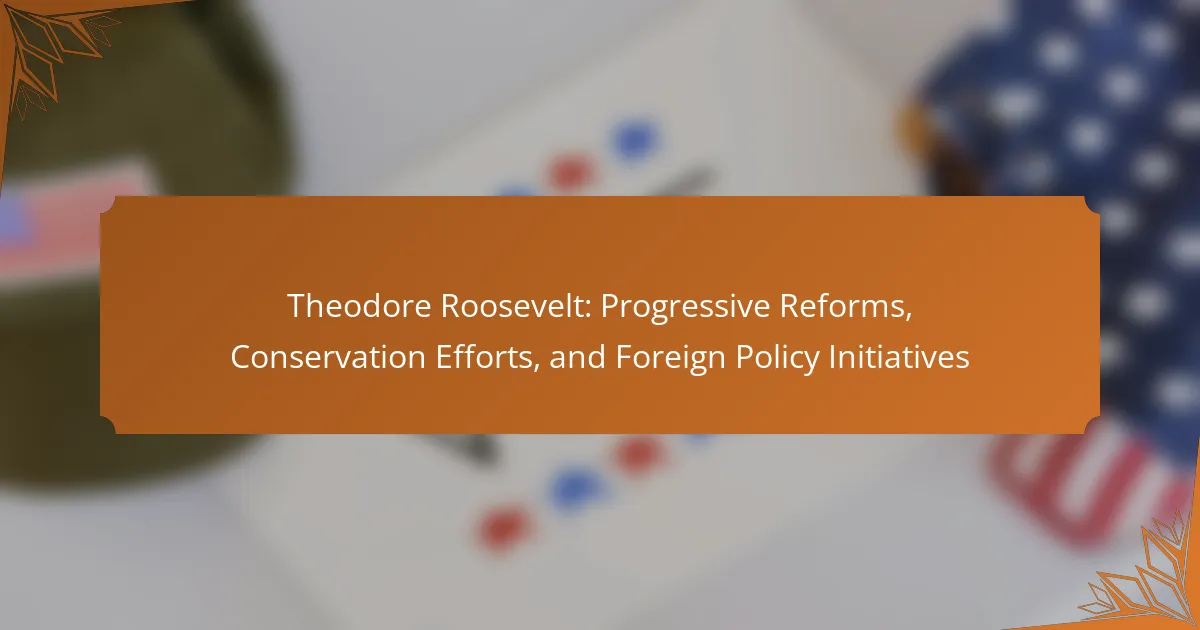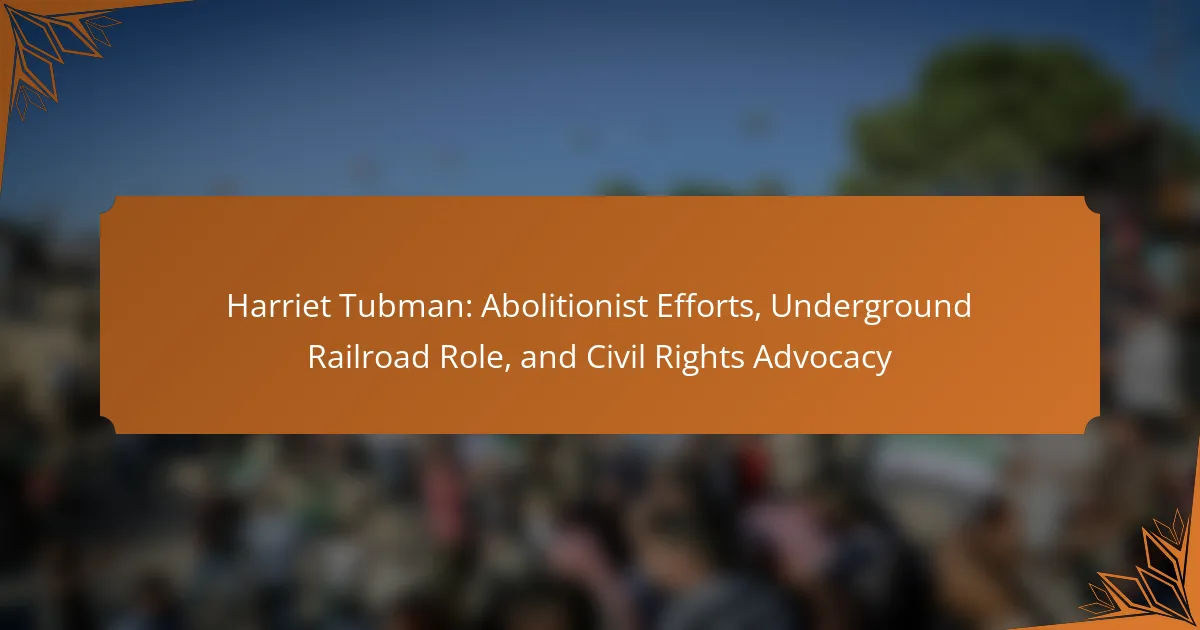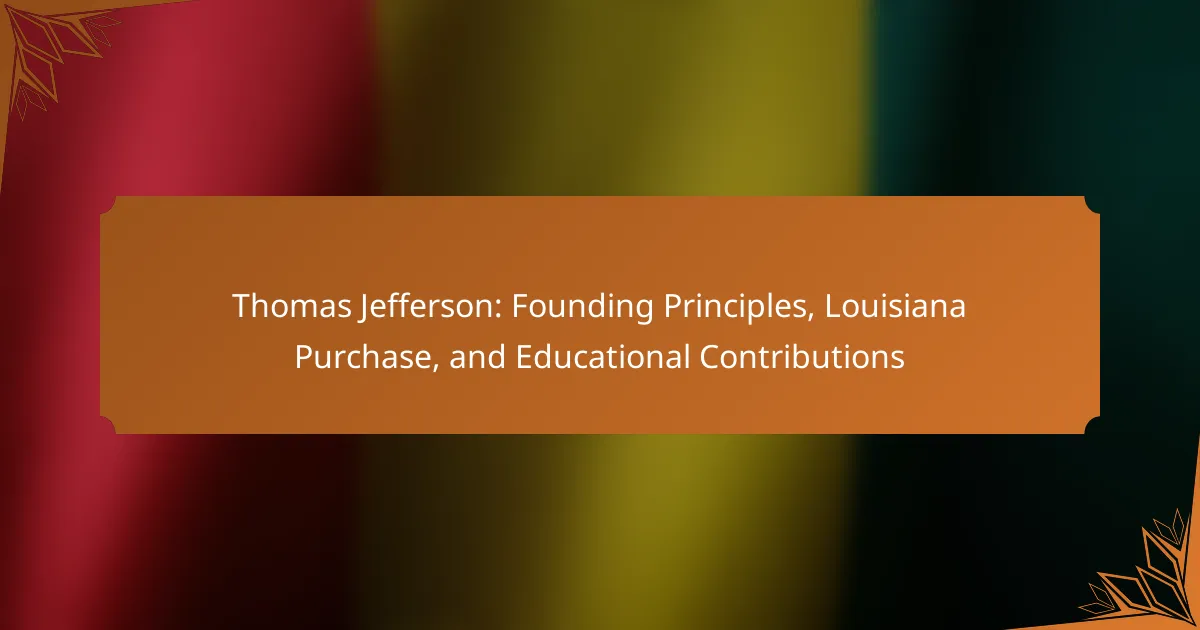Theodore Roosevelt served as the 26th President of the United States from 1901 to 1909 and is recognized for his significant contributions to progressive reforms, conservation efforts, and foreign policy initiatives. He implemented the Square Deal to protect consumers and regulate corporations, and he advanced environmental protection through the establishment of national parks and the United States Forest Service. Roosevelt’s foreign policy, characterized by “Big Stick Diplomacy,” included the construction of the Panama Canal and the Roosevelt Corollary to the Monroe Doctrine, which asserted U.S. influence in Latin America. His leadership not only transformed American politics and society but also established the United States as a formidable global power.
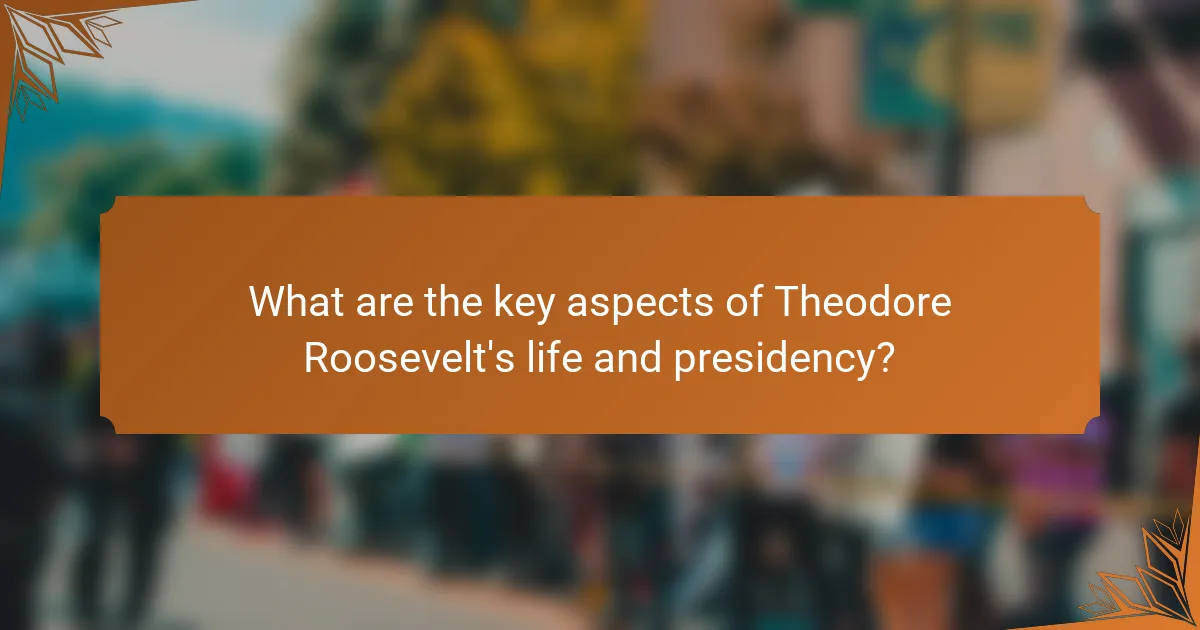
What are the key aspects of Theodore Roosevelt’s life and presidency?
Theodore Roosevelt was the 26th President of the United States from 1901 to 1909. He was known for his progressive reforms, including trust-busting and regulation of railroads. Roosevelt championed the Square Deal, which aimed to protect consumers and promote fair labor practices. He significantly expanded the National Parks system, advocating for conservation and environmental protection. Roosevelt’s foreign policy included the construction of the Panama Canal and the Roosevelt Corollary to the Monroe Doctrine. He received the Nobel Peace Prize in 1906 for mediating the Russo-Japanese War. His dynamic personality and leadership style left a lasting impact on American politics and society.
How did Roosevelt’s early life influence his political career?
Theodore Roosevelt’s early life significantly shaped his political career. He was born into a wealthy family in 1858, which provided him with access to education and influential connections. His early health challenges, including asthma, fostered a strong determination and resilience. Roosevelt’s exposure to nature during childhood instilled a lifelong passion for conservation. His education at Harvard and involvement in extracurricular activities developed his leadership skills. Additionally, his experience in the New York State Assembly introduced him to political processes. These formative experiences cultivated his progressive ideals and commitment to reform. Ultimately, his early life laid the groundwork for his future policies on conservation and social justice.
What significant events shaped Roosevelt’s worldview?
The significant events that shaped Roosevelt’s worldview include his experiences with the Spanish-American War and his time as a rancher in the Badlands. The Spanish-American War in 1898 influenced his belief in American imperialism and military strength. His role as a Rough Rider during the war showcased his commitment to national service. Additionally, his time in the Badlands cultivated a deep appreciation for nature and conservation. The challenges he faced in the wilderness fostered his belief in the importance of preserving natural resources. These experiences contributed to his progressive reforms and conservation efforts as president. Roosevelt’s worldview was further shaped by the industrialization of America, which highlighted the need for regulation and social justice. His exposure to the struggles of the working class during this period informed his policies aimed at addressing economic inequality.
How did Roosevelt’s personality traits affect his leadership style?
Roosevelt’s personality traits significantly influenced his leadership style. His energetic and charismatic nature inspired confidence and loyalty among his supporters. Roosevelt’s assertiveness led him to take decisive actions, such as the Square Deal policies. His optimism fostered a sense of hope during challenging times, particularly during the Progressive Era. Roosevelt’s adventurous spirit encouraged bold reforms in conservation and labor rights. His strong will enabled him to face opposition head-on, exemplified by his trust-busting efforts against monopolies. Additionally, his empathy allowed him to connect with the public, enhancing his appeal as a leader. These traits combined to create a dynamic and impactful leadership style that shaped American politics.
What were the main progressive reforms initiated by Theodore Roosevelt?
Theodore Roosevelt initiated several key progressive reforms. He championed the Square Deal, focusing on consumer protection, labor rights, and curbing corporate power. The Pure Food and Drug Act of 1906 established federal regulations for food safety. The Meat Inspection Act of 1906 ensured sanitary conditions in the meatpacking industry. Roosevelt also advocated for the regulation of monopolies through the Sherman Antitrust Act. He established numerous national parks and forests, promoting conservation efforts. The Newlands Reclamation Act of 1902 aimed to manage water resources for agriculture. These reforms collectively aimed to improve social justice and environmental stewardship.
How did Roosevelt address corporate monopolies during his presidency?
Theodore Roosevelt addressed corporate monopolies through vigorous enforcement of antitrust laws. He believed in regulating large corporations to promote fair competition. Roosevelt’s administration filed lawsuits against major monopolies, including the Northern Securities Company in 1902. This landmark case led to the Supreme Court ordering the company to dissolve. He also supported the Elkins Act of 1903, which targeted railroad rebates. Additionally, the Hepburn Act of 1906 strengthened the Interstate Commerce Commission’s authority. Roosevelt’s actions challenged the power of monopolies and aimed to protect consumers and small businesses. His approach established a precedent for future antitrust enforcement in the United States.
What role did Roosevelt play in labor rights and worker protections?
Theodore Roosevelt played a significant role in advancing labor rights and worker protections during his presidency. He championed the Square Deal, which aimed to ensure fairness for workers. Roosevelt intervened in the 1902 Coal Strike, advocating for arbitration between miners and owners. This marked the first time a president took a neutral stance in a labor dispute. He established the Bureau of Corporations to investigate corporate practices and promote fair competition. Roosevelt also supported the establishment of the Department of Labor in 1913, which focused on labor issues. His administration enacted the Pure Food and Drug Act and the Meat Inspection Act, enhancing consumer protections. Roosevelt’s efforts laid the groundwork for future labor reforms and protections in the United States.
How did Roosevelt’s policies impact public health and safety regulations?
Roosevelt’s policies significantly strengthened public health and safety regulations. His administration established the Pure Food and Drug Act in 1906. This act aimed to eliminate harmful substances in food and pharmaceuticals. Roosevelt also championed the Meat Inspection Act, which mandated sanitary conditions in meatpacking plants. These regulations improved consumer safety and public health standards. Roosevelt’s focus on regulating industries marked a shift toward government oversight. His efforts laid the groundwork for future health and safety legislation. Overall, Roosevelt’s policies enhanced the protection of American consumers.
Why is conservation a significant aspect of Roosevelt’s legacy?
Conservation is a significant aspect of Roosevelt’s legacy because he established a comprehensive national conservation policy. Roosevelt created five national parks, 18 national monuments, and 150 national forests. He protected over 230 million acres of public land. His policies laid the groundwork for modern environmentalism. The Antiquities Act of 1906 was a key tool he used for conservation. Roosevelt’s leadership in conservation inspired future generations to prioritize environmental protection. His efforts contributed to the establishment of the National Park Service in 1916. This legacy continues to influence conservation efforts today.
What specific conservation efforts did Roosevelt implement?
Theodore Roosevelt implemented several specific conservation efforts during his presidency. He established the United States Forest Service in 1905. This agency aimed to manage and protect national forests. Roosevelt designated five national parks, including Crater Lake and Wind Cave. He also created 18 national monuments, safeguarding significant natural and cultural sites. Roosevelt signed the Antiquities Act in 1906, empowering him to protect landmarks. He set aside approximately 230 million acres of public land for conservation. This included forests, wildlife refuges, and national parks. These efforts significantly expanded the federal government’s role in environmental preservation.
How did Roosevelt’s views on nature influence national parks and forests?
Theodore Roosevelt’s views on nature significantly influenced the establishment and expansion of national parks and forests. His belief in the importance of conservation led to the creation of five national parks. Roosevelt also established 18 national monuments, protecting over 230 million acres of public land. He was a strong advocate for preserving natural resources for future generations. His administration enacted the Antiquities Act, allowing for the designation of protected areas. Roosevelt’s vision emphasized the balance between development and conservation. This legacy continues to shape America’s conservation policies today. His actions laid the groundwork for the modern conservation movement.
What was the impact of Roosevelt’s conservation policies on future generations?
Roosevelt’s conservation policies significantly shaped environmental stewardship for future generations. His establishment of national parks, forests, and wildlife refuges preserved vast natural resources. Roosevelt created five national parks and 18 national monuments, protecting over 230 million acres of public land. These actions laid the groundwork for the modern conservation movement. Future generations benefited from increased awareness of environmental issues and the importance of biodiversity. His policies also inspired subsequent legislation, including the National Park Service Organic Act of 1916. This act ensured the preservation of natural and cultural resources for public enjoyment. Roosevelt’s legacy continues to influence environmental policies today.
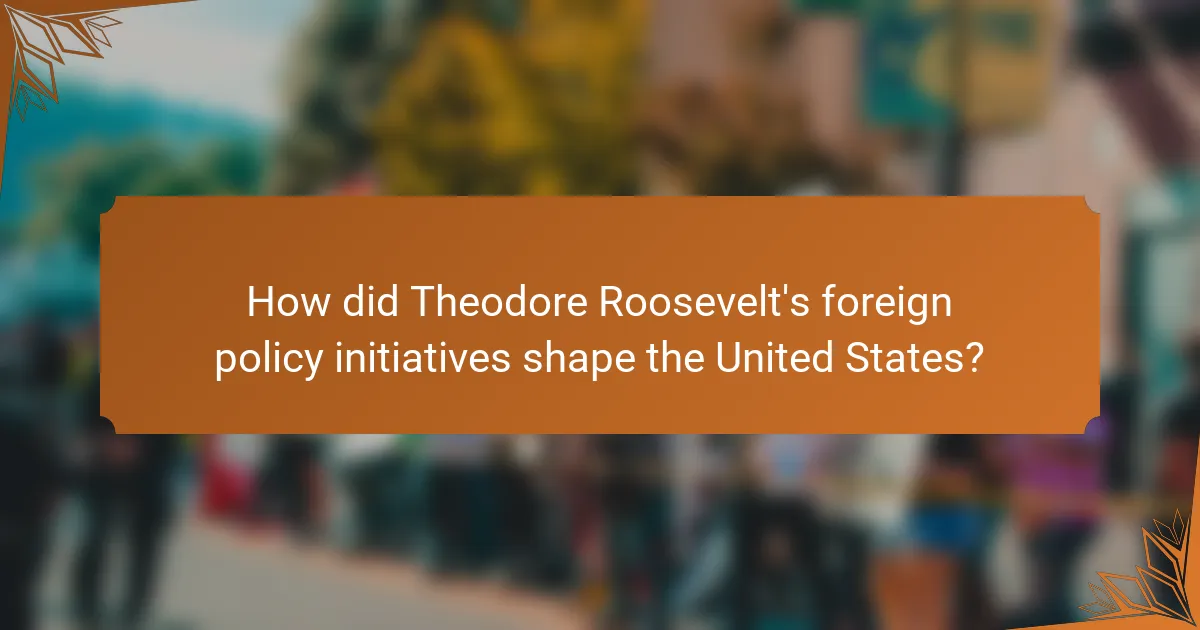
How did Theodore Roosevelt’s foreign policy initiatives shape the United States?
Theodore Roosevelt’s foreign policy initiatives significantly shaped the United States by establishing it as a global power. His approach, known as “Big Stick Diplomacy,” emphasized military strength and readiness. Roosevelt’s negotiation of the Treaty of Portsmouth in 1905 ended the Russo-Japanese War, marking the first time a Western nation mediated a conflict between Asian powers. This enhanced America’s reputation internationally. Additionally, the construction of the Panama Canal under Roosevelt’s leadership facilitated trade and military movement, further asserting U.S. influence in the Western Hemisphere. Roosevelt’s Corollary to the Monroe Doctrine justified American intervention in Latin America, reinforcing U.S. dominance in the region. These initiatives collectively transformed the United States into a key player on the world stage.
What were the key principles of Roosevelt’s foreign policy?
The key principles of Roosevelt’s foreign policy included the Big Stick Diplomacy, the Roosevelt Corollary, and the promotion of American economic interests. Big Stick Diplomacy emphasized military strength to achieve diplomatic goals. The Roosevelt Corollary asserted the U.S. right to intervene in Latin America to maintain stability. Roosevelt also sought to expand U.S. influence through trade and investment in foreign markets. His approach aimed to ensure that the Western Hemisphere remained free from European intervention. These principles shaped U.S. foreign relations in the early 20th century.
How did the Roosevelt Corollary alter U.S. relations with Latin America?
The Roosevelt Corollary significantly altered U.S. relations with Latin America by establishing the United States as a dominant power in the region. This policy was introduced in 1904 as an extension of the Monroe Doctrine. It asserted that the U.S. would intervene in Latin American countries to maintain stability and order. The corollary justified American intervention in domestic affairs of these nations. This led to increased military presence and influence in countries like the Dominican Republic and Nicaragua. The Roosevelt Corollary shifted U.S. foreign policy from isolationism to active interventionism. It fostered a perception of the U.S. as a police power in the Western Hemisphere. This change had lasting impacts on diplomatic relations and regional dynamics.
What role did diplomacy and military power play in Roosevelt’s foreign strategy?
Diplomacy and military power were central to Theodore Roosevelt’s foreign strategy. Roosevelt believed in the importance of a strong military to support diplomatic efforts. He famously stated, “Speak softly and carry a big stick.” This phrase encapsulated his approach. Roosevelt used diplomacy to negotiate peace while maintaining military readiness. For example, he mediated the end of the Russo-Japanese War in 1905. This earned him the Nobel Peace Prize. Additionally, he expanded the U.S. Navy, showcasing military strength. The Great White Fleet’s voyage in 1907 demonstrated American naval power globally. Roosevelt’s strategy blended diplomacy and military might effectively, shaping U.S. foreign relations.
How did Roosevelt’s foreign policy reflect his overall vision for America?
Roosevelt’s foreign policy reflected his vision for America by promoting a strong international presence. He believed in American exceptionalism and the nation’s role as a global leader. Roosevelt’s approach included the “Big Stick” diplomacy, which emphasized military strength to achieve foreign policy goals. This was evident in the construction of the Panama Canal, which showcased American engineering and strategic interests. Additionally, Roosevelt mediated the Russo-Japanese War, earning the Nobel Peace Prize for his efforts. His policies aimed to assert U.S. influence, particularly in Latin America, through the Roosevelt Corollary to the Monroe Doctrine. This approach underscored his belief that America should intervene in the affairs of weaker nations to maintain stability. Thus, Roosevelt’s foreign policy was a direct reflection of his vision for a proactive and powerful America on the world stage.
In what ways did Roosevelt’s approach to foreign affairs differ from his predecessors?
Roosevelt’s approach to foreign affairs was more assertive than his predecessors. He emphasized a strong military presence and the use of diplomacy backed by force. This was evident in his “Big Stick” policy, which advocated for intervention in international conflicts. Unlike earlier leaders, Roosevelt actively sought to expand American influence globally. He brokered the end of the Russo-Japanese War, earning a Nobel Peace Prize in 1906. Roosevelt also initiated the construction of the Panama Canal, demonstrating a commitment to strategic infrastructure. His approach marked a shift from isolationism to a more interventionist stance in global affairs.
How did Roosevelt’s foreign policy initiatives contribute to America’s global standing?
Roosevelt’s foreign policy initiatives significantly enhanced America’s global standing. His approach included the Roosevelt Corollary to the Monroe Doctrine. This asserted the U.S. right to intervene in Latin America to maintain stability. It positioned the U.S. as a dominant power in the Western Hemisphere.
Additionally, Roosevelt brokered the end of the Russo-Japanese War. This earned him the Nobel Peace Prize in 1906, showcasing U.S. diplomatic influence. His efforts in constructing the Panama Canal further solidified America’s strategic and economic power.
By promoting the “Big Stick” diplomacy, Roosevelt emphasized military strength as a means of negotiation. This policy increased respect for the U.S. among world powers. Overall, his initiatives laid the groundwork for America’s emergence as a global leader in the early 20th century.
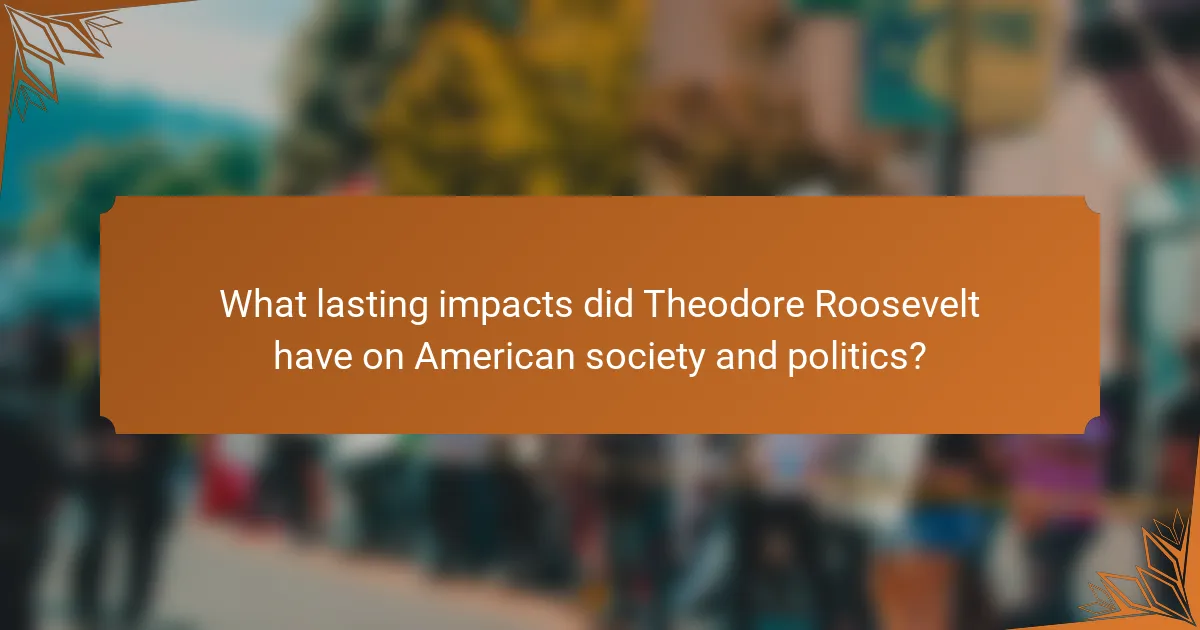
What lasting impacts did Theodore Roosevelt have on American society and politics?
Theodore Roosevelt significantly shaped American society and politics through progressive reforms and conservation efforts. He championed the Square Deal, which aimed to protect consumers, regulate corporations, and conserve natural resources. Under his administration, the Pure Food and Drug Act and the Meat Inspection Act were enacted in 1906, ensuring safer food and drugs for the public. Roosevelt’s commitment to conservation led to the establishment of five national parks and the creation of the United States Forest Service. He also significantly expanded the role of the federal government in economic affairs, promoting antitrust actions against monopolies. His foreign policy initiatives, particularly the Roosevelt Corollary to the Monroe Doctrine, asserted American influence in Latin America. These actions set precedents for future presidents and solidified the government’s role in regulating industry and protecting the environment. Roosevelt’s legacy continues to influence contemporary debates on conservation and corporate regulation.
How did Roosevelt influence the Progressive Movement beyond his presidency?
Roosevelt influenced the Progressive Movement beyond his presidency by promoting progressive ideals and policies that persisted after his term. His emphasis on social justice, environmental conservation, and government regulation set a framework for future reforms. Roosevelt’s establishment of national parks and forests laid the groundwork for the conservation movement. He advocated for the Square Deal, which focused on consumer protection and labor rights. These principles continued to inspire subsequent leaders and legislation. His role in the creation of the Food and Drug Administration in 1906 established standards that lasted long after his presidency. Roosevelt’s legacy encouraged future reforms, including the New Deal and civil rights movements. His vision of an active government role in economic and social issues became a cornerstone of American progressivism.
What were the long-term effects of Roosevelt’s reforms on American politics?
Roosevelt’s reforms had significant long-term effects on American politics. They established a precedent for federal government intervention in the economy. The Progressive Era reforms reshaped the relationship between the government and citizens. They increased public expectation for government accountability and regulation. Roosevelt’s trust-busting efforts led to stronger antitrust laws. The establishment of regulatory agencies became a norm. His conservation policies initiated a long-lasting commitment to environmental protection. Roosevelt’s reforms ultimately laid the groundwork for future social and economic legislation.
How did Roosevelt’s conservation efforts shape future environmental policies?
Roosevelt’s conservation efforts established a framework for modern environmental policies. He created five national parks and 18 national monuments. These actions emphasized the importance of preserving natural resources. Roosevelt also expanded the National Forest System, protecting millions of acres of land. His administration laid the groundwork for future conservation legislation. The Antiquities Act of 1906 became a tool for future presidents to protect natural and cultural resources. Roosevelt’s vision influenced the establishment of the U.S. Forest Service. His legacy continues to inspire contemporary environmental movements and policies.
What lessons can be learned from Theodore Roosevelt’s presidency?
Theodore Roosevelt’s presidency teaches the importance of progressive reform and environmental conservation. He championed the Square Deal, focusing on fairness for workers, consumers, and businesses. Roosevelt’s administration saw significant antitrust actions, breaking up monopolies like Northern Securities Company in 1904. His commitment to conservation led to the establishment of five national parks and 18 national monuments. Roosevelt also expanded the United States’ role in global affairs through the Panama Canal’s construction. His “speak softly and carry a big stick” approach emphasized diplomacy backed by military strength. Overall, his presidency underscores the value of proactive leadership in addressing social and environmental issues.
How can modern leaders apply Roosevelt’s principles in today’s political climate?
Modern leaders can apply Roosevelt’s principles by embracing progressive reforms that promote social justice and equity. Roosevelt championed the Square Deal, which aimed to ensure fair treatment for all citizens. Leaders today can advocate for policies that address income inequality and access to healthcare.
Additionally, Roosevelt’s conservation efforts highlight the importance of environmental stewardship. Modern leaders can prioritize sustainable practices and climate change initiatives. This aligns with Roosevelt’s belief in protecting natural resources for future generations.
Furthermore, Roosevelt’s assertive foreign policy emphasized the importance of diplomacy combined with strength. Leaders today can adopt a balanced approach in international relations, promoting peace while maintaining national security.
By integrating these principles, modern leaders can navigate today’s political climate effectively. Roosevelt’s legacy provides a framework for addressing contemporary challenges through reform, conservation, and diplomacy.
What are the best practices for effective leadership based on Roosevelt’s example?
Effective leadership practices based on Roosevelt’s example include decisiveness, integrity, and the ability to inspire. Roosevelt demonstrated decisiveness through his swift actions in implementing progressive reforms. He championed the Square Deal, addressing issues like labor rights and consumer protection. His integrity was evident in his commitment to fairness and transparency, earning public trust. Additionally, Roosevelt inspired others by embodying the “strenuous life” philosophy, encouraging citizens to engage actively in civic duties. His leadership during the Panama Canal construction showcased vision and determination, leading to significant national and international impact.
Theodore Roosevelt, the 26th President of the United States, served from 1901 to 1909 and is recognized for his progressive reforms, conservation efforts, and significant foreign policy initiatives. Key aspects of his presidency include the implementation of the Square Deal, which aimed to protect consumers and regulate corporations, as well as the establishment of national parks and forests to promote environmental conservation. Roosevelt’s foreign policy, characterized by “Big Stick Diplomacy,” asserted U.S. influence globally, particularly in Latin America, and included the construction of the Panama Canal. His leadership style, shaped by his energetic personality and commitment to reform, left a lasting impact on American politics and society, influencing future generations and shaping the Progressive Movement.
